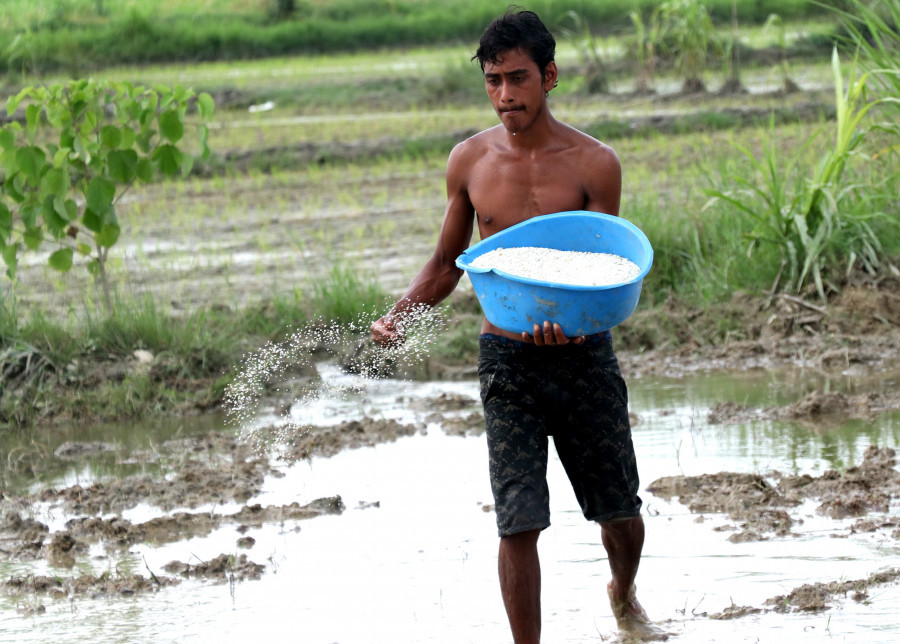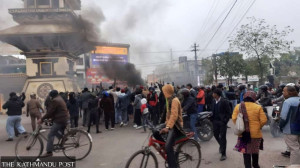National
Food insecurity, economic slowdown loom as acute shortage of fertilisers is going to hit paddy production
This year, fertiliser was supplied neither from the government’s mechanism nor from illegal traders, as their clandestine supply lines were severed by the Covid-19 lockdown and border restrictions.
Sangam Prasain
The government has almost doubled the budget for subsidised chemical fertilisers in view of the perennial shortage that is the bane of Nepali farmers, but paddy growers are yet to see any of the plant nutrients.
Farmer Janardan Bari of Kapilvastu was not able to get diammonium phosphate (DAP), the world's most widely used phosphorus fertiliser, to grow paddy seedlings. Paddy is planted in seed beds before being transplanted in puddled soil.
Bari expects to encounter another shortage of urea when the top dressing of paddy begins in July-end after it has been transplanted.
"I travelled to different depots to get DAP, but I had to return empty-handed most of the time,” said Bari. He added that his paddy seedlings were not growing as well as they should.
This is not the first time that farmers like Bari are facing shortages of chemical fertilisers.
Subsidised nutrients distributed by the government fulfil only 40 percent of the country’s demand, and the rest of the requirement is met by illegal imports from India.
This year, fertiliser was neither to be had from the government’s supply mechanism nor from illegal traders, as their clandestine supply lines were severed by the Covid-19 lockdown and strict border restrictions that have been in place to prevent the spread of the virus.
Tens of thousands of farmers, who rely on contraband fertilisers that used to pass easily into the country through the 1,700-kilometre leaky border with India, will be severely hit, and this may aggravate food insecurity.
The World Food Programme and the World Bank have both warned that as the coronavirus crisis unfolds, disruptions to domestic food supply chains and other shocks could affect food production and cause insecurity.
Farmer Bari had no problems getting fertiliser last year because if he couldn't get it at the local market, he would just amble down to the market across the border for all his needs.
Another farmer, Shambhu Prasad Yadav of Rohini Rural Municipality, Rupandehi, has transplanted his paddy saplings without waiting for fertiliser. Yadav took home 17 tonnes of paddy last November. He is worried that his harvest may drop sharply this year.
"If I had waited for fertiliser, my field would have remained barren," he said.
Kapilvastu and Rupandehi districts have high rates of Covid-19 infection. Farmers say they are forced to travel to various cooperatives and offices of state-owned Agricultural Inputs Company in search of chemical fertilisers despite the hazard.
Farmer Darshanath Kohar of Tilaura, Kapilvastu, who makes his family budget based on the income from his paddy crop, said his harvest could shrink this year for the lack of fertiliser. “I am worried about feeding my family."
Fertiliser is a vital input for agriculture production.
According to Bhola Man Singh Basnet, an agricultural scientist who previously served at Nepal Agricultural Research Council, timely use of chemical fertilisers increases paddy productivity by 20 percent.
“If farmers fail to apply urea during the first top dressing, which occurs approximately two weeks after transplanting, it hampers rapid vegetative growth of the plant,” said Basnet. “And there are chances of a disease attack."
Kapilvastu needs 2,000 tonnes of DAP and 7,000 tonnes of urea every year to grow paddy.
Dinesh Sharma, chief of the Agriculture Inputs Company in Taulihawa, said their stock of chemical fertiliser has run out and that they had not issued any since April-end.
“We have 250 tonnes of DAP and 100 tonnes of urea that will barely last two-three days amid frenzied buying,” said Sharma. Since panic buying is increasing, it’s a risk to open sales.
The Ministry of Agriculture and Livestock Development said it had planned to distribute 450,000 tonnes of chemical fertilisers this fiscal year ending mid-July, which is 100,000 tonnes more than last year’s supply.
“We import chemical fertiliser mainly from China and the Middle East, and our plan was hit by their high virus caseloads,” the ministry said in a statement issued on June 10.
A shipment of 50,000 tonnes of chemical fertiliser dispatched by the manufacturer remains stranded at Kolkata and Kandla ports in Gujarat, India for the last two months due to a lack of workers.
The ministry said that a consignment of another 50,000 tonnes had been dispatched from different fertiliser producing plants, but it would take at least one and a half months to arrive. It is not certain that the shipment will reach Nepal on the date–by July-end–expected by the ministry.
The ministry said that it is doing all it can to avert a crisis, but some experts said a 'severe crisis' of chemical fertiliser is imminent.
Nepal requires 120,000 tonnes of urea and 50,000 tonnes of DAP for planting paddy on 1.5 million hectares of land. According to Agriculture Ministry sources, warehouses across the country have run out of chemical fertiliser.
The government had increased the budget for the distribution of subsidised chemical fertilisers from Rs5 billion to Rs9 billion for this fiscal year to ensure timely and adequate supply. The budget announced on May 28 again increased the subsidy amount to Rs11 billion.
According to the Agriculture Ministry, the annual demand for chemical fertiliser stands at more than 700,000 tonnes while imports amount to around 300,000 tonnes.
A study conducted by the Finance Ministry in 2006 put the share of informal fertiliser imports at 71 percent of total supplies. Private companies in Nepal are reluctant to trade in fertiliser due to the high cost and risks, and all imports and distribution are conducted by Agriculture Inputs Company and Salt Trading, both state-owned enterprises.
According to reports, as border controls are being put in place to contain the spread of the virus, cross-border trade in critical inputs like seed, fertiliser, plant protection products and on-farm equipment could be constrained.
These barriers to trade increase transaction costs, in turn reducing margins for smallholder farmers and potentially decreasing their on-farm investments as well. Reduced on-farm investments could inhibit farmers’ resilience to unrelated shocks — such as droughts and pest and disease outbreaks—and generally limit their productive capacity even further.
Chaturbhuj Mani Tripathi, president of the District Farmers' Association in Kapilvastu, said farmers are planting paddy without fertiliser, and this would impact production. "Farmers may lose income as production will not be good,” said Tripathi.
In Rupandehi, 60 percent of the farmers have planted their paddy crops without fertiliser.
Ganesh Ghimire, spokesperson for the Agricultural Inputs Company in Bhairahawa, said 13,312 tonnes of fertiliser had been sent to Rupandehi and surrounding districts like Gulmi and Pyuthan. But officials said it was risky to distribute such small amounts of fertiliser as they would be mobbed by frantic farmers.
In Nawalparasi, farmers are not only facing a fertiliser crisis, but are also dealing with shortage of farm workers. Hundreds of workers used to come from Bihar, India during the planting season, but the lockdown has prevented their travel this year.
“We didn't have fertiliser and hybrid seeds,” said Harendra Yadav of Palhinandan, Nawalparasi. “And now we have difficulties finding farm hands.”
(With inputs from Manoj Poudel in Kapilvastu, Sanju Poudel in Tilottama and Nabin Poudel in Parasi)




 6.3200000000001°C Kathmandu
6.3200000000001°C Kathmandu








%20(1).jpg&w=300&height=200)






